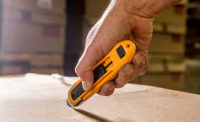Arc flash clothing is a special kind of safety workwear that protects the user from the threat of flash fires, including spontaneous combustions, which can occur when hazardous gasses are present. Employers need to ensure that their workers are equipped with arc flash clothing that is properly rated for the situation at hand. Individuals that work in areas where a flash fire could likely occur should understand how arc flash clothing is tested, rated, and classified when shopping for the right personal protective equipment (PPE).
The basics
Arc flash clothing, or arc-rated (AR) clothing — not to be confused with fire resistant (FR) clothing — is designed and tested to protect the wearer when working near electrical equipment or anywhere prone to flash fires and arc flash hazards. All arc flash workwear is flame resistant, but not all FR clothing is qualified to protect you from arc flash hazards.
Since flash fires can occur quickly without warning, workers may not have a chance to escape the flames. Arc flash clothing prevents the fire from spreading and the person’s clothes from burning until they can reach safety. FR clothing may help shield workers from flames that cause life-threatening burns, but it won’t protect the person in the event of a spontaneous combustion. While FR clothing can reduce the chances of ignition and protect workers against burns, it has a threshold where the protection is not the same as that of arc flash workwear.
AR clothing is made with special flame-resistant materials and reinforced stitching patterns to prevent the clothing from breaking down in a fire. All arc flash clothing is tested and rated based on its ability to prevent second-degree burns.
Arc flash testing
The arc flash testing process involves exposing the sample item to a flash fire. There are several rating standards for arc flash clothing, including: ASTM F1506, ASTM F1959, IEC 61482-2, IEC 61482-1-1 Method A, and IEC 61482-1-1 Method B. According to ASTM F1959, at least 20 samples of clothing must be tested and perform consistently when exposed to heat and fire before the item can be approved. During the testing process, sensors will measure heat levels running through the fabric based on the Stoll Curve, which determines the level of heat needed to create a second-degree burn. The test calculates the point where there is a 50% possibility of the wearer experiencing the onset of a second-degree burn. If holes open in the fabric before the 50% probability threshold is reached, the Energy Break-Open Threshold (EBT) is calculated, expressed in calories per centimeter squared. This is what’s known as the arc rating of the fabric. It can be displayed as ATPV (Arc Thermal Performance Value) or EBT. Both can be calculated during the same test, but the more conservative rating is used.
Arc flash ratings & classification
Arc flash clothing that passes the testing process will then receive a rating based on its performance. These ratings and classifications were created to help managers and individuals find the right type of arc flash workwear depending on the risk of a flash fire and potential exposure level. There are four categories based on its arc flash rating, measured in cal/cm2. Each category is rated for a particular ATPV. The National Fire Protection Association (NFPA) provides the following four arc flash clothing ratings:
- Category 1: Minimum Arc Rating of 4 cal/cm2. It involves a single layer of arc flash clothing.
- Category 2: Minimum Arc Rating of 8 cal/cm2. It feels about the same as Category 1 with more protection, so many companies usually opt for Category 2.
- Category 3: Minimum Arc Rating of 25 cal/cm2. It is usually worn by firefighters and includes an arc-rated flash hood, insulating gloves, and additional PPE.
- Category 4: Minimum Arc Rating of 40 cal/cm2
The clothing should come with a label that lists the arc flash rating and classification to keep workers in the know. Individuals should never use FR clothing without an arc flash rating label.
In addition to being tested for arc flash protection, all AR clothing should be comfortable to wear. The individual should be able to move around uninhibited in the workplace. Managers can use clothing with adjustable straps and bands so workers can adjust the fit to their body size. Arc flash clothing is often worn in combination with other pieces of workwear. It may include pants, jacket, coveralls, insulating gloves, parka, headliners, boots, face hoods, and rain gear when working in wet conditions. Workers should ensure that all their arc flash workwear falls into the same category.
Arc flash clothing also needs to be maintained over time to ensure it still meets the same protection requirements. Workers should inspect their AR workwear for damage before starting the shift, including holes, weak spots, and loose threads. Arc flash clothing can be repaired but only if the person uses the same arc flash material to patch the rip or hole.
Workers should adhere to manufacturer’s directions when laundering and disinfecting their arc flash gear. Certain detergents and fabric softeners will ruin the clothing’s flame-resistant properties, which leave workers exposed to flash fires hazards.
Working around flash fires can be extremely dangerous. Any exposure to an open flame could result in lasting injuries, including blindness and even death. Companies facing a risk of flash fire should know the difference between FR and AR clothing and teach their workers how to use these garments on the job. Proper training, care, and maintenance of these garments can make a huge difference and save lives.



